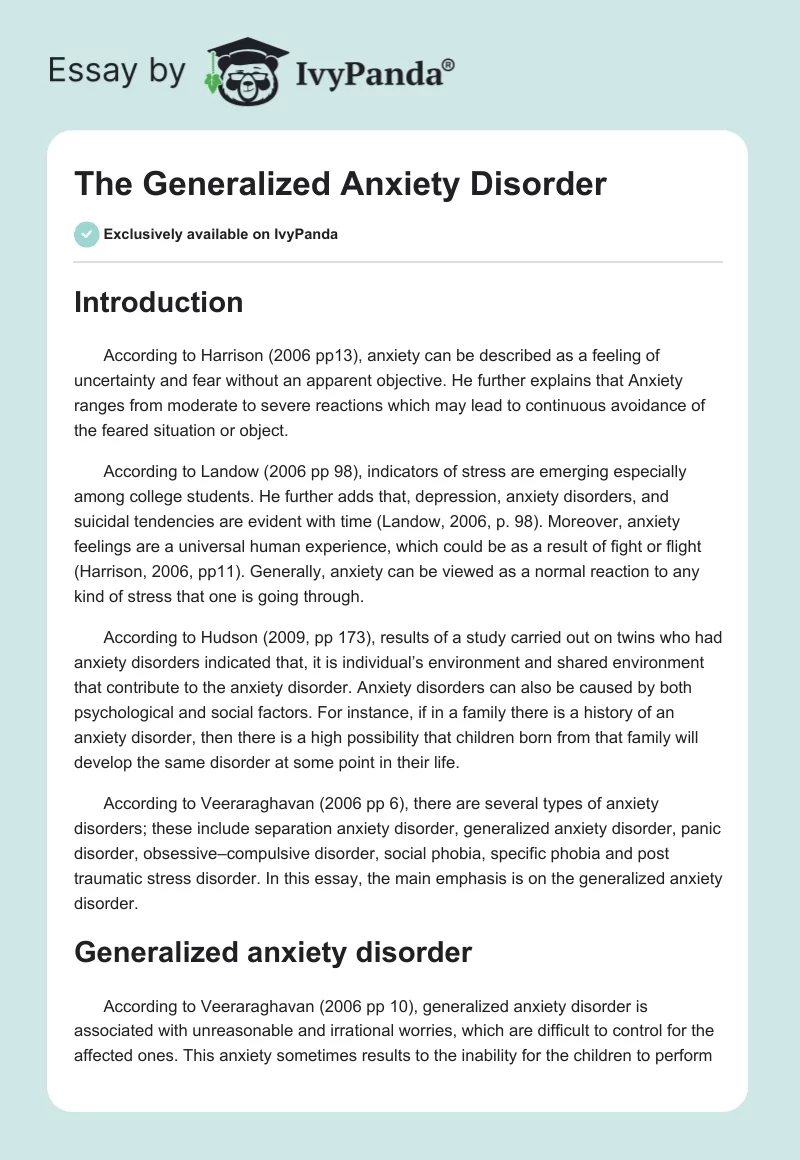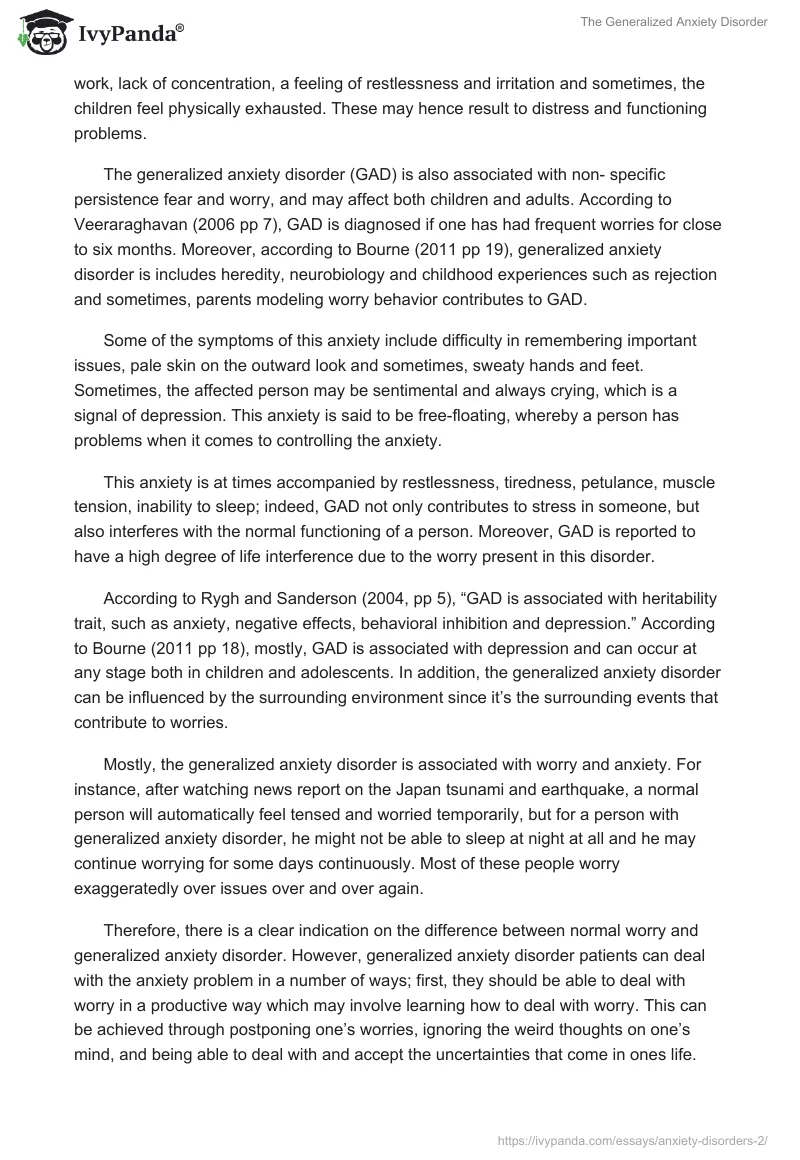Introduction
According to Harrison (2006 pp13), anxiety can be described as a feeling of uncertainty and fear without an apparent objective. He further explains that Anxiety ranges from moderate to severe reactions which may lead to continuous avoidance of the feared situation or object.
According to Landow (2006 pp 98), indicators of stress are emerging especially among college students. He further adds that, depression, anxiety disorders, and suicidal tendencies are evident with time (Landow, 2006, p. 98). Moreover, anxiety feelings are a universal human experience, which could be as a result of fight or flight (Harrison, 2006, pp11). Generally, anxiety can be viewed as a normal reaction to any kind of stress that one is going through.
According to Hudson (2009, pp 173), results of a study carried out on twins who had anxiety disorders indicated that, it is individual’s environment and shared environment that contribute to the anxiety disorder. Anxiety disorders can also be caused by both psychological and social factors. For instance, if in a family there is a history of an anxiety disorder, then there is a high possibility that children born from that family will develop the same disorder at some point in their life.
According to Veeraraghavan (2006 pp 6), there are several types of anxiety disorders; these include separation anxiety disorder, generalized anxiety disorder, panic disorder, obsessive–compulsive disorder, social phobia, specific phobia and post traumatic stress disorder. In this essay, the main emphasis is on the generalized anxiety disorder.
Generalized anxiety disorder
According to Veeraraghavan (2006 pp 10), generalized anxiety disorder is associated with unreasonable and irrational worries, which are difficult to control for the affected ones. This anxiety sometimes results to the inability for the children to perform work, lack of concentration, a feeling of restlessness and irritation and sometimes, the children feel physically exhausted. These may hence result to distress and functioning problems.
The generalized anxiety disorder (GAD) is also associated with non- specific persistence fear and worry, and may affect both children and adults. According to Veeraraghavan (2006 pp 7), GAD is diagnosed if one has had frequent worries for close to six months. Moreover, according to Bourne (2011 pp 19), generalized anxiety disorder is includes heredity, neurobiology and childhood experiences such as rejection and sometimes, parents modeling worry behavior contributes to GAD.
Some of the symptoms of this anxiety include difficulty in remembering important issues, pale skin on the outward look and sometimes, sweaty hands and feet. Sometimes, the affected person may be sentimental and always crying, which is a signal of depression. This anxiety is said to be free-floating, whereby a person has problems when it comes to controlling the anxiety.
This anxiety is at times accompanied by restlessness, tiredness, petulance, muscle tension, inability to sleep; indeed, GAD not only contributes to stress in someone, but also interferes with the normal functioning of a person. Moreover, GAD is reported to have a high degree of life interference due to the worry present in this disorder.
According to Rygh and Sanderson (2004, pp 5), “GAD is associated with heritability trait, such as anxiety, negative effects, behavioral inhibition and depression.” According to Bourne (2011 pp 18), mostly, GAD is associated with depression and can occur at any stage both in children and adolescents. In addition, the generalized anxiety disorder can be influenced by the surrounding environment since it’s the surrounding events that contribute to worries.
Mostly, the generalized anxiety disorder is associated with worry and anxiety. For instance, after watching news report on the Japan tsunami and earthquake, a normal person will automatically feel tensed and worried temporarily, but for a person with generalized anxiety disorder, he might not be able to sleep at night at all and he may continue worrying for some days continuously. Most of these people worry exaggeratedly over issues over and over again.
Therefore, there is a clear indication on the difference between normal worry and generalized anxiety disorder. However, generalized anxiety disorder patients can deal with the anxiety problem in a number of ways; first, they should be able to deal with worry in a productive way which may involve learning how to deal with worry. This can be achieved through postponing one’s worries, ignoring the weird thoughts on one’s mind, and being able to deal with and accept the uncertainties that come in ones life.
In order to be able to relax, GAD patients should involve themselves in activities such as exercises, meditation, and taking deep breaths once in a while, hence reducing the rate of stress or depression. According to Smith and Jaffe-Gill (2010), self-sooth is the most essential tool to deal with anxiety and worry. Some of their tips include; taking a walk to the park and breathing the fresh air, listening to music when you feel tense, lighting scented candles and smelling of fresh flowers, cooking a delicious meal for yourself, and getting a massage.
Theories associated with generalized anxiety disorder
The generalized anxiety disorder is mainly associated with worry, hence the worry avoidance theory tries to explore further on GAD. According to Heimberg (2004 pp 14), worry can be defined as a chain of thoughts and images, with negative effect and uncontrollable problems arising there from.
He further explains that, worry can serve as a means of avoidance to the negative aversive images. Therefore, the best remedy for worry is avoiding worries at all times. According to the author, the cognitive avoidance theory of worry is actually an avoidance response to danger. He explains that the world is a dangerous place and one may not be able to cope with what the future brings; thus, one must anticipate all the bad things that happen so as to avoid or prepare for them.
Worry can serve as a cognitive avoidance strategy in three ways; worry suppresses anxious arousal, worry functions as an attempt to prevent or prepare for the future and worry as a focus on events that distract from more pressing emotion concerns. People who have GAD should avoid uncomfortable emotions and stop living in multiple emotions. In conclusion, this theory indicates that worry is a negatively reinforced cognitive avoidance response.
According to Hudson (2010 pp 155), young children are also aware of their worries, and according to research, they even admit that it is difficult to control these worries. According to Portman (2009 pp 33), Barlow’s emotion theory focuses on the generalized anxiety. He further explains that “there is a synergy that takes place between a generalized biological vulnerability and generalized psychological vulnerability” (Portman, 2009).
The Barlow’s theory signifies that worry may be a process that is independent from anxiety (Rapee and Hudson, 2010). According to Barlow’s theory, generalized psychological vulnerability creates a neurotic temperament; but when the generalized biological factor that forms the genetic influence is added to the early experiences and vulnerability, it leads to GAD.
Treatment
According to Bourne (2011 pp 19), there are a number of treatments that one can refer to in order to curb the generalized anxiety behavior. Relation training involves deep breath relaxation techniques as an exercise. Secondly, the cognitive therapy involves identifying fearful worries and replacing them with realistic thinking.
This therapy helps one to understand that, worrying only increases the probability of odds of something negative happening. Thirdly, worry exposure includes strategies that would help one cope with the disturbing images or fears. Reducing worry behavior is another strategy that helps one reduce on a behavior that involves worry.
Problem solving is also another strategy that involves solving of that particular problem that one is worried about and also learning to accept the situations that one cannot change. Distraction involves diverting attention to some other activities apart from ones worries; this could include listening to music, gardening, cooking and swimming.
Lastly, there are medications such as Zoloft, luvox, and lexapro used and have been found effective in treating generalized anxiety disorder (Bourne, 2011 pp 19-20). Moreover, involving the family in the treatment of the anxiety disorders may yield to better outcomes. This is because the family members will be able to understand the disorder well enough in order to assist the affected person.
Conclusion
At any given time, it is normal for any human being to worry, but when ones worries become regular that they affect one’s normal routine, such that one cannot sleep, then, that is a problem. The generalized anxiety disorder is usually a combination of heredity, neurobiology and predisposing childhood experiences that include parental expectation, rejection and parent’s modeling worry behavior. Nevertheless, generalized anxiety disorder can be said to be any stressful situation that may contribute to fear (Edmund 2009 pp 34).
However, for every problem, there is a solution. Hence, GAD is a disorder that can be subsided through a number of ways such as treatment in form of medication or in form of therapy. GAD patients can also benefit from the acceptance of the anxiety, watching on one’s anxiety, functioning with the anxiety, and expecting the best if they continue accepting the functioning and watching the anxiety.
References
Bourne, E. (2011). The Anxiety and Phobia Workbook. Fifth Edition. CA: New harbinger publications.
Edmund, J. (2009). Anxiety & Phobia Workbook: Easy read Comfort. Fourth Edition. NY: ReadHowYouWant.com. Web.
Harrison, A. and Hart, C. (2006). Mental health care for nurses: applying mental health skills in the general hospital. Fifth Edition. NY: Wiley- Blackwell publishers.
Heimberg. R. (2004). Generalized anxiety disorder: advances in research and practice. NY: Guilford Press publishers.
Hudson, J. and Ellis, D. (2010). The Metacognitive Model of Generalized Anxiety Disorder in Children and Adolescents. NY: Springer science + business media publishers.
Landow, M. (2006). Stress and mental health of college students. NY: Nova publishers.
Portman, M. (2009). Generalized Anxiety Disorder Across the Lifespan: An Integrative Approach. NY: Springer publisher.
Rapee, R. and Hudson, L. Family and social environments in the etiology and maintenance of anxiety disorder. (Attached material).
Rygh, J. and Sanderson, W. (2004). Treating generalized anxiety disorder: evidence-based strategies, tools, and techniques. NY: Guilford press publishers.
Smith, M. and Jaffe-Gill, E. (2010). Generalized Anxiety Disorder (GAD). Web.
Veeraraghavan, V. (2006). Behaviour Problems in Children and Adolescents. Northern Book Centre publishers.


